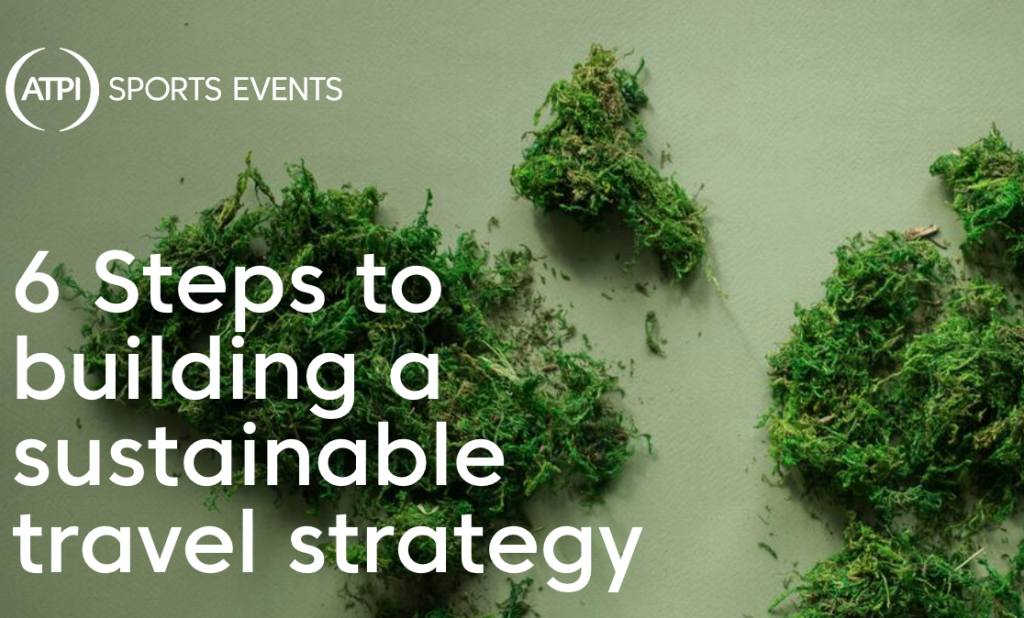Six Steps To Building A Sustainable Travel Strategy
February 21, 2022
On Thursday this week iSportConnect will be hosting a round table looking at how sports rights holders and organisations are trying to adapt their sustainable strategy. In this piece, ATPI Sports Events look at six steps to building a sustainable travel strategy.
As more teams work towards achieving the goal of becoming carbon neutral, travel managers are likely to find that travel will be put under the spotlight.
“It’s the perfect time to develop an engaged project team that will ensure your sustainable travel strategy comes to fruition.”
There’s no denying that travel contributes to an team’s carbon footprint and that the best way to limit their impact on the environment would be to dramatically reduce their travel. However, it’s important to appreciate that travel is necessary in order to succeed as a team and so developing a sustainable strategy for any travel is essential.
Our sustainability experts have developed this short guide for sports teams and organisations who are looking to review their travel strategy in order to make it more sustainable for the future:
1. Assemble your internal champions
Sustainability is a topic that is on a lot of peoples’ minds outside of work right now and so it’s the perfect time to develop an engaged project team that will ensure your sustainable travel strategy comes to fruition.
By bringing together stakeholders from departments such as travel, procurement, human resources, marketing and communications you will be able to collect enough opinion and anecdotal evidence to build an outline of your strategy and give the project an initial sense of direction.
Planning regular meetings and plotting realistic deadlines for the project will ensure that it maintains momentum and ultimately delivers results.
2. Talk to your travel management company
As travel experts, your travel organisers should have a confirmed stance on sustainability and also be in communication with suppliers about what they are doing to make their products more environmentally friendly.
Working as closely as possible throughout the project will deliver the best results – they should understand your team/organisation’s culture, your travel habits, wider team goals and be able to predict and monitor the success of the project by analysing your travel data. They can share best practices and advice on what your industry peers are doing, ensuring that your plans get off to the best possible start.
3. Create your goals
As with any decision for change or a move to implement a new initiative, it’s vital that all stakeholders are clear on why your team is deciding to do this now. Has this been a goal that’s been on the agenda for a while? Is there increasing governmental or legislative pressure? Or societal pressure? Understanding why your teamis deciding to take action now is the first step in crafting realistic yet motivational goals.
“When you come to create more specific goals, it might be useful to consider the 17 Sustainable Development Goals developed by the United Nations.”
When you come to create more specific goals, it might be useful to consider the 17 Sustainable Development Goals developed by the United Nations and match your team’s goals to those that you feel resonate the most. It can also be helpful to consider the travel process in three stages; pre, during and post travel, and then build sustainability goals for each stage. Adding measurable targets and KPIs to some of these goals will also help to drive progress over the year ahead.
4. Understand your travel data
When you begin to work with your travel organiser to make your travel strategy more sustainable they will want to know how your team is travelling. A consolidated overview, where possible, will deliver the best results. It’s this insight that will allow you and your travel organiser to make informed decisions about how to amend your team’s approach to travel in a realistic way.
Identifying your team’s travel habits will show if there are routine parts of travel that can be amended to become more environmentally friendly.
“Teams and individuals can ‘offset’ the impact of some of the CO2 emissions produced by their flights, ground transportation and other travel activities by purchasing carbon credits and investing in projects that reduce or store carbon.”
It’s also important to build CO2 reporting into this process. Understanding the size of your team’s carbon footprint will provide you with a clear starting point from which to improve, as well as enabling you to develop a robust plan for offsetting.
5. Identify and engage key suppliers
Identifying which suppliers your travellers most frequently book with can be a great place to start when trying to pull together a plan for increased sustainability. For example, if your organisation has corporate rates with a particular hotel chain, find out what that chain is doing to improve environmentally-friendly practices within its hotels. The same approach can be applied to your most frequently travelled routes.
6. Offset your travel
Teams and individuals can ‘offset’ the impact of some of the CO2 emissions produced by their flights, ground transportation and other travel activities by purchasing carbon credits and investing in projects that reduce or store carbon. These projects include renewable energy generation, improving energy efficiency, reducing deforestation and planting more trees.
One carbon offset credit represents 1 metric ton of CO2e reduced or averted from the atmosphere.
ATPI has created its own carbon offsetting service, ATPI Halo. ATPI Halo is a proactive step towards changing the way the sports and business travel sector views sustainable travel and to pioneer industry-leading approaches to making travel greener. You can find out more about ATPI Halo here.


